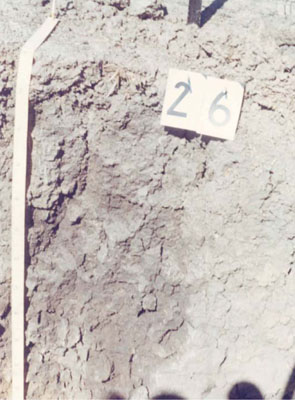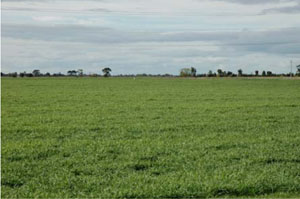WIA22
|
| WIA22 |  Endocalcareous-Endohypersodic, Massive, Grey Vertosol | |
|
Location | Riverside, western Victoria | |||
|
Landform | Terrace | |||
|
Geology | Quaternary Coonambidgal Formation: fluvial to lacustrine clays and sands | |||
|
Element | Terrace flat | |||
|
Slope | 0–1% | |||
|
Aspect | – | |||
Horizon | Depth (cm) | Description | ||
A1 | 0–5 | Dark grey (10YR4/1); medium clay; cracking massive (structureless) surface condition when undisturbed; weak subangular blocky structure; very strong consistence dry; moderately sticky consistence wet; pH 6.3; sharp and smooth boundary to: | ||
B21 | 5–25 | Dark grey (10YR4/1); light medium clay; subplastic; moderate coarse prismatic structure; strong consistence dry; moderately sticky consistence wet pH 7.1: | ||
B22 | 25–60 | Dark grey (10YR4/1); heavy clay; moderate coarse prismatic structure; weak consistence dry; moderately sticky consistence wet; very few (<2%) hard carbonate segregations; pH 7.2; gradual and smooth boundary to: | ||
B31 | 60–95 | Grey (10YR5/1); heavy clay; plastic; moderate coarse subangular structure; very few (<2%) hard carbonate segregations; pH 6.4; gradual boundary to: | ||
B32 | 95–115 | Light greyish brown (10YR6/2); heavy clay; plastic; moderate coarse subangular structure; very strong consistence dry; moderately sticky consistence wet; very few (<2%) hard carbonate segregations; pH 6.3; gradual boundary to: | ||
B33 | 115–150 | Greyish brown (10YR5/2); heavy clay; plastic; strong coarse angular blocky structure; strong consistence dry; moderately sticky consistence wet; very few (<2%) hard carbonate segregations pH 5.9. | ||
| Management considerations | ||||
| ||||
Site WIA22 | Sample depth cm | pH | EC dS/m | NaCl % | Ex Ca cmol-/kg | Ex Mg cmol-/kg | Ex K cmol-/kg | Ex Na cmol-/kg | Ex Al mg/kg | Ex acidity cmol-/kg | FC -30okPa | PWP -1500okPa | KS % | FS % | Z % | C % | |
Horizon | H2O | CaCl2 | |||||||||||||||
A1 | 0–5 | 6.3 | 5.4 | 0.12 | 0.02 | 7.2 | 10 | 0.7 | 0.8 | NA | 8 | NA | 22.7 | 1 | 27 | 27 | 44 |
B21 | 5–25 | 7.1 | NA | 0.14 | 0.03 | 10.1 | 16.2 | 0.8 | 2.7 | NA | 8.6 | NA | 21.1 | 0 | 14 | 20 | 65 |
B22 | 25–60 | 7.2 | NA | 0.53 | 0.11 | 9.8 | 16.2 | 0.7 | 4.2 | NA | 6.4 | NA | 23.8 | 0 | 13 | 23 | 61 |
B23 | 60–95 | 6.4 | NA | 0.14 | 0.14 | 9.2 | 15.9 | 0.6 | 5.2 | NA | 6.3 | NA | 21.9 | 0 | 12 | 24 | 63 |
B31k | 95–115 | 6.3 | NA | 0.74 | 0.12 | 7.5 | 13 | 0.6 | 5.2 | NA | 7.5 | NA | 21.4 | 1 | 13 | 24 | 61 |
B32 | 115–150 | 5.9 | NA | 0.86 | 0.17 | 6.9 | 12.4 | 0.6 | 4.5 | NA | 7.5 | NA | 20.7 | 0 | 14 | 23 | 62 |



